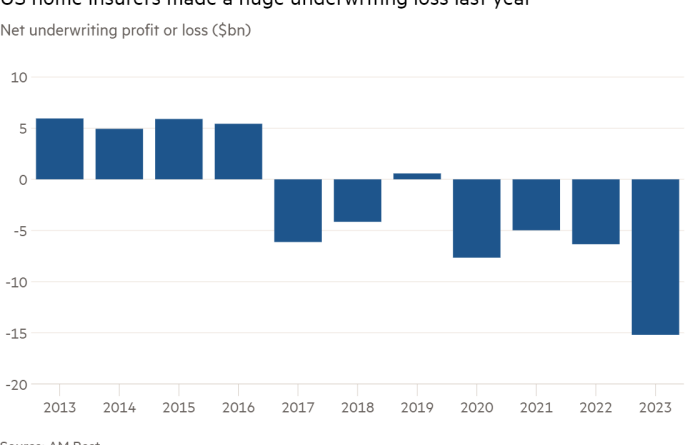An insecure world: rethinking how to cover climate damage
This is the third part of an FT series on the effects of climate change on insurance. Read the first part Here and the second part Here.
Thomas Brennan is in a good position to see the growing pressure of climate change on American business insecurity. An insurance salesman, he is also a member of the extended Brennan family that has owned restaurants throughout New Orleans since his grandfather’s generation.
The downtown area – like many other areas exposed to floods, fires or storms – has been hit hard by insurance defaults, hit by the toxic mix of inflation in claims costs and increasing weather conditions. extreme.
The rush to find affordable insurance, Brennan says, has hit businesses like his family harder than it did after Hurricane Katrina in 2005, the world’s costliest hurricane.
“I would argue that the market is worse now than it was then,” he said to the Financial Times, about the challenge of finding personal flood insurance. The last state insurance scheme exists but has a limit of $500,000 for building damage and separate contents cover.
“The limit [of additional cover available through private-sector policies] it went broke, rates went up, deductibles were high,” Brennan said.
Brennan’s restaurants have become FloodFlash, a UK start-up which is one of a growing group of insurers, large and small, offering a type of insurance known as parametric: it covers a set amount of based on a predetermined goal.
In this case, the cause is a water sensor in the protester’s area. A flood of sufficient depth will be covered, and the claim paid promptly at the prescribed rate.
Parametric insurance is just one way the global insurance industry is trying to protect homes and businesses as climate change causes extreme weather and increased losses.
Another strategy for getting more attention is to adapt. After bottling company Coca-Cola Consolidated suffered severe flooding at its Nashville plant in 2010, it worked with its FM insurer to repair the plant, so that floodwaters could flow through of the building without damaging electrical equipment and other vulnerable areas.
When the floodwaters returned with a vengeance ten years later, the damage was minimal and the plant went down in days instead of weeks.
Such efforts give hope to the insurance industry that a combination of preventive and adaptive measures by property owners, as well as new methods of measuring or insuring risks, will be sufficient to meet the challenge of the climate.
Paula Jarzabkowski, a risk expert at the University of Queensland, is an advocate of a new insurance “ecosystem” of public and private projects that can keep households and businesses free as the planet warms.
In this view, the global performance of the insurance of last resort that is currently provided by government schemes alone will not be enough. “Many things we already have . . . he is not mature enough to fix the problem we are in,” he said.
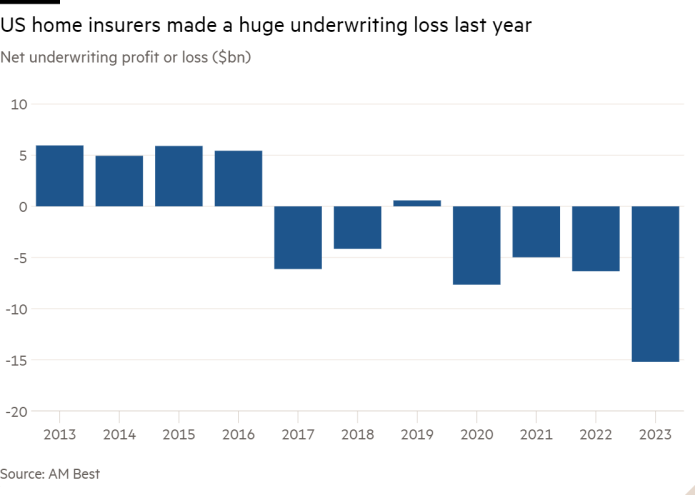
Private-sector innovation falls largely into two buckets: near-risk equity – which can remove enough uncertainty to provide traditional asset protection – or find new forms of insurance.
Risk modeling companies have recently poured investments into technology that they say can identify risks posed by local events such as fires and floods that may affect a building on one side of the street and not the other. .
“We’re now in a position where we can provide more advanced modeling techniques, and more information about this type of risk, because we now have the computing power to do that,” said Julie Serakos, head of the model product management team. Moody’s RMS risk provider.
There are different methods. Based on the many sources of data available to underwriters, specialist property insurers such as London-listed Hiscox are able to analyze the risk on a house-by-house basis.
And startups have emerged, like Delos, founded in San Francisco in 2017, using machine learning and satellite data to gain a comprehensive understanding of the wildfire risk of individual properties — with the goal of providing protection to families that others use at high risk. values can be avoided.
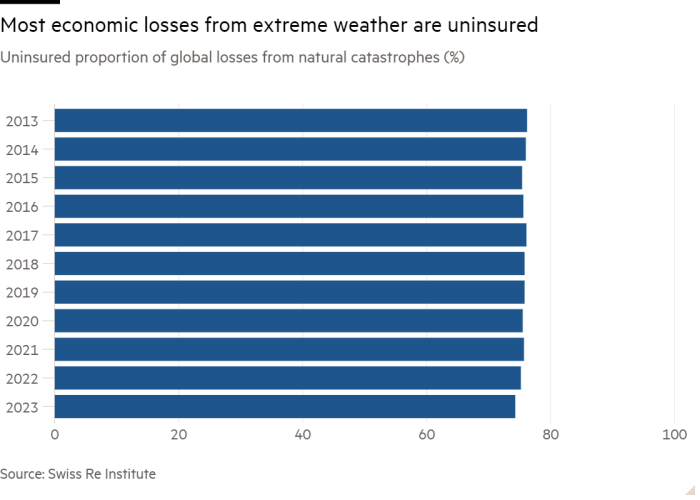
Some insurers rely on third-party climate experts, such as US-based Jupiter Intelligence, which provide advance assessments of how climate change will affect their business.
The insurance market has also been supported by the proliferation of structures such as disaster bonds – a growing form of protection against extreme weather conditions offered by investors through securities. Printing has increased in recent years.
Parametric rules are also gradually being used by even the largest in the industry. “Thanks to the parametric process, exposure to uncertainty becomes impossible,” said Aon, one of the largest insurance brokers.
But experts say there are pitfalls to some of these methods. For example, parametric insurance puts the risk that a flood or a hurricane does not hit the exact cause it needs, and there is no protection at all.
While more granular analysis may allow some properties to be labeled differently, it may also widen the divide between those properties and those considered “good risks” and “bad risks”.
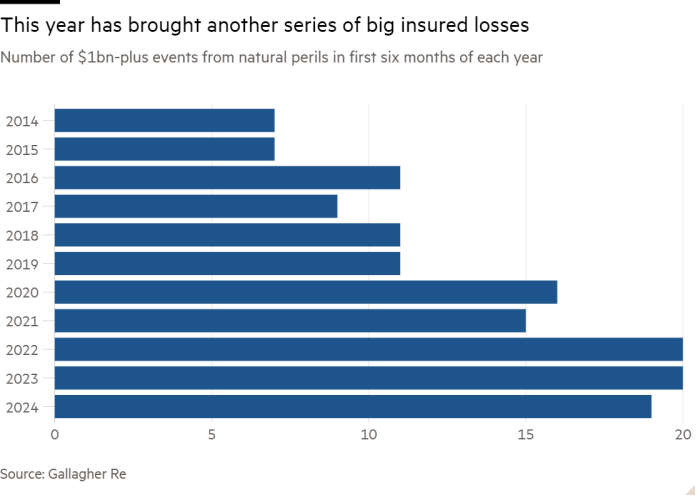
Policy makers are also very concerned about the role of local and national governments in providing the latter.
Petra Hielkema, head of Eiopa, the EU’s insurance regulator, told the FT that there was growing support among politicians in the bloc – the world’s warmest continent – for plans to risk sharing country for natural disasters. “The next step”, he added, would be the pan-EU project that was presented by the regulator and the European Central Bank last year.
“These [natural catastrophe] problems, of this magnitude, will eventually need a European solution,” said Hielkema, although he added that it would have to be carefully constructed to avoid moral hazard such as reducing the incentive for individual countries to invest in measures to make a living.
Meanwhile, there are small ways, such as a pilot program to provide low and moderate families in New York in flood-prone areas with an emergency cash payment after a major flood.
Others think that it is up to the local community to cooperate with the insurance industry and regulators on the question of insurability.
InnSure, a non-profit organization that promotes new insurance solutions for climate risk, says that community leaders can “protect their insecurities” by using insurance-focused assessments to development and new processes.
“Just asking, ‘If we do this, what are the insurance implications and the economic implications’, can have a huge impact, as unaffordable insurance can affect household prices and destroy public wealth,” said Charlie Sidoti, its chief executive.
For some managers, the way forward is to recognize the scale of the problem and adapt – working with customers or families to protect themselves from water or fire that reaches the door, or making sure it doesn’t cause major damage when you do that. They say that such actions can keep insurance costs at a reasonable level.
FM chief executive Malcolm Roberts told the FT that requests from companies such as the Coca-Cola bottler for its opt-out service, which creates its own risk maps for natural hazards, are at an unprecedented level.
The company has been providing insurance and protection since 1835, when Rhode Island textile mill owners created mutual insurance for those willing to take preventive measures such as thick floors and firewalls to reduce fire losses.
“When insurance costs a lot, that’s when people start saying, ‘What can I do with it?'” said Roberts.
Climate Capital
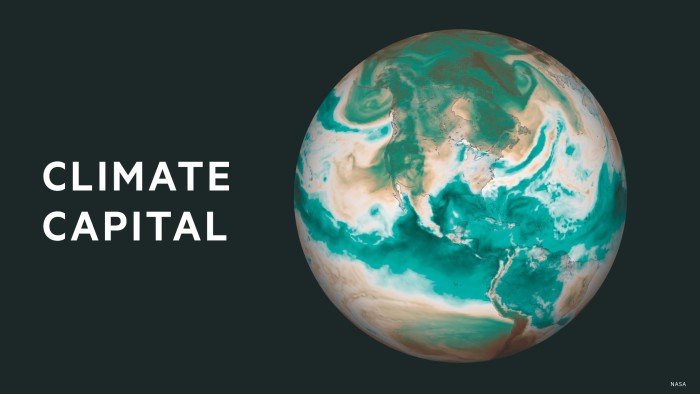
Where climate change meets business, markets and politics. Check out the FT news here.
Curious about FT’s commitment to the environment? Find out more about our science-based goals here
#insecure #world #rethinking #cover #climate #damage
